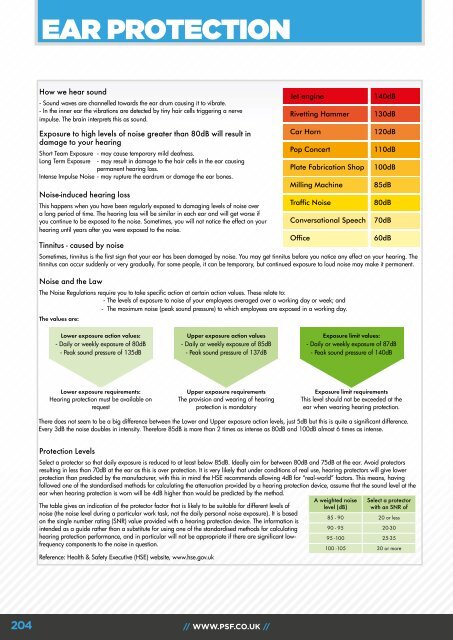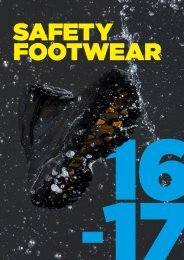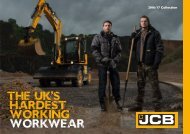Progressive Safety Footwear, Workwear and PPE Catalogue 2016/17
Create successful ePaper yourself
Turn your PDF publications into a flip-book with our unique Google optimized e-Paper software.
NOISE AT WORK<br />
information<br />
EAR<br />
& support<br />
PROTECTION<br />
How we hear sound<br />
- Sound waves are channelled towards the ear drum causing it to vibrate.<br />
- In the inner ear the vibrations are detected by tiny hair cells triggering a nerve<br />
impulse. The brain interprets this as sound.<br />
Exposure to high levels of noise greater than 80dB will result in<br />
damage to your hearing<br />
Short Tea m Exposure - may cause temporary mild deafness.<br />
Long Term Exposure - may result in damage to the hair cells in the ear causing<br />
permanent hearing loss.<br />
Intense Impulse Noise - may rupture the eardrum or damage the ear bones.<br />
Noise-induced hearing loss<br />
This happens when you have been regularly exposed to damaging levels of noise over<br />
a long period of time. The hearing loss will be similar in each ear <strong>and</strong> will get worse if<br />
you continue to be exposed to the noise. Sometimes, you will not notice the effect on your<br />
hearing until years after you were exposed to the noise.<br />
Tinnitus - caused by noise<br />
Noise <strong>and</strong> the Law<br />
Jet engine<br />
Rivetting Hammer<br />
Car Horn<br />
Pop Concert<br />
Plate Fabrication Shop<br />
Milling Machine<br />
Traffic Noise<br />
Conversational Speech<br />
Office<br />
The Noise Regulations require you to take specific action at certain action values. These relate to:<br />
- The levels of exposure to noise of your employees averaged over a working day or week; <strong>and</strong><br />
- The maximum noise (peak sound pressure) to which employees are exposed in a working day.<br />
The values are:<br />
140dB<br />
130dB<br />
120dB<br />
110dB<br />
100dB<br />
Sometimes, tinnitus is the first sign that your ear has been damaged by noise. You may get tinnitus before you notice any effect on your hearing. The<br />
tinnitus can occur suddenly or very gradually. For some people, it can be temporary, but continued exposure to loud noise may make it permanent.<br />
85dB<br />
80dB<br />
70dB<br />
60dB<br />
Lower exposure action values:<br />
- Daily or weekly exposure of 80dB<br />
- Peak sound pressure of 135dB<br />
Upper exposure action values<br />
- Daily or weekly exposure of 85dB<br />
- Peak sound pressure of 137dB<br />
Exposure limit values:<br />
- Daily or weekly exposure of 87dB<br />
- Peak sound pressure of 140dB<br />
Lower exposure requirements:<br />
Hearing protection must be available on<br />
request<br />
Upper exposure requirements<br />
The provision <strong>and</strong> wearing of hearing<br />
protection is m<strong>and</strong>atory<br />
Exposure limit requirements<br />
This level should not be exceeded at the<br />
ear when wearing hearing protection.<br />
There does not seem to be a big difference between the Lower <strong>and</strong> Upper exposure action levels, just 5dB but this is quite a significant difference.<br />
Every 3dB the noise doubles in intensity. Therefore 85dB is more than 2 times as intense as 80dB <strong>and</strong> 100dB almost 6 times as intense.<br />
Protection Levels<br />
Select a protector so that daily exposure is reduced to at least below 85dB. Ideally aim for between 80dB <strong>and</strong> 75dB at the ear. Avoid protectors<br />
resulting in less than 70dB at the ear as this is over protection. It is very likely that under conditions of real use, hearing protectors will give lower<br />
protection than predicted by the manufacturer, with this in mind the HSE recommends allowing 4dB for “real-world” factors. This means, having<br />
followed one of the st<strong>and</strong>ardised methods for calculating the attenuation provided by a hearing protection device, assume that the sound level at the<br />
ear when hearing protection is worn will be 4dB higher than would be predicted by the method.<br />
The table gives an indication of the protector factor that is likely to be suitable for different levels of<br />
noise (the noise level during a particular work task, not the daily personal noise exposure). It is based<br />
on the single number rating (SNR) value provided with a hearing protection device. The information is<br />
intended as a guide rather than a substitute for using one of the st<strong>and</strong>ardised methods for calculating<br />
hearing protection performance, <strong>and</strong> in particular will not be appropriate if there are significant lowfrequency<br />
components to the noise in question.<br />
Reference: Health & <strong>Safety</strong> Executive (HSE) website, www.hse.gov.uk<br />
A weighted noise<br />
level (dB)<br />
Select a protector<br />
with an SNR of<br />
85 - 90 20 or less<br />
90 - 95 20-30<br />
95 -100 25-35<br />
100 -105 30 or more<br />
MOLDEX-METRIC AG & CO. KG UK & IRELAND TEL: +44 [0]1159854288 INFO@UK.MOLDEX-EUROPE.COM<br />
204<br />
// WWW.PSF.CO.UK //





